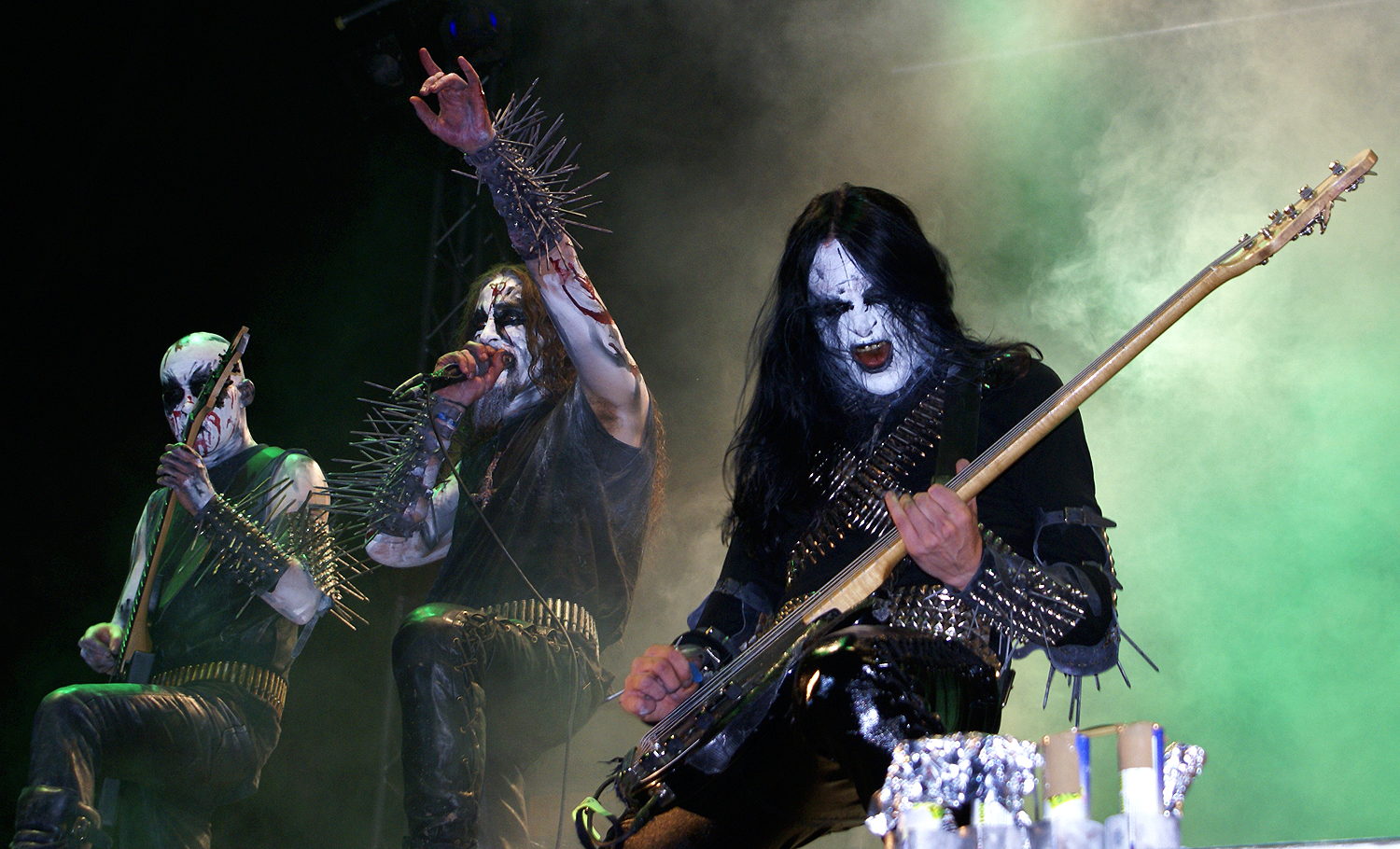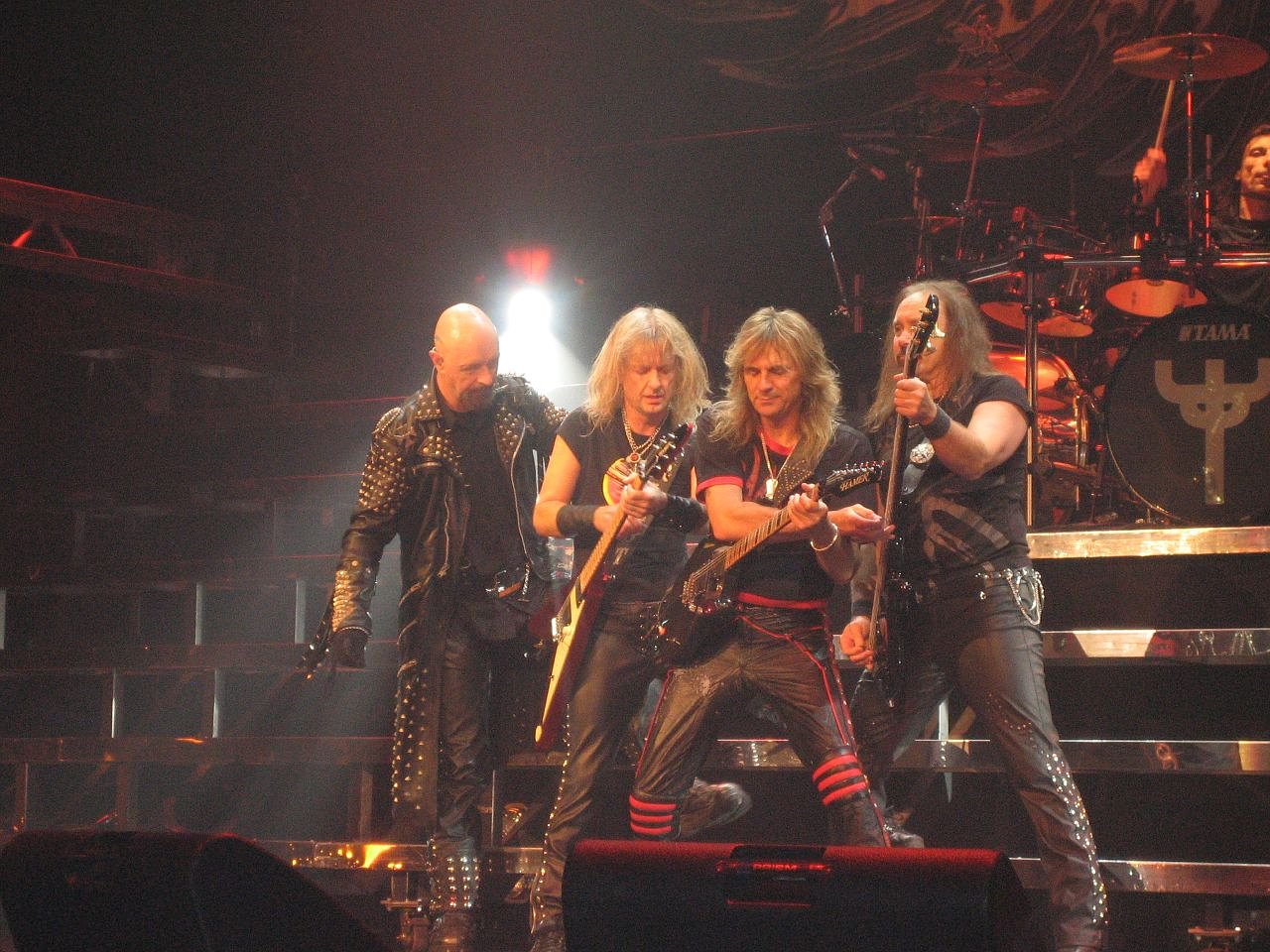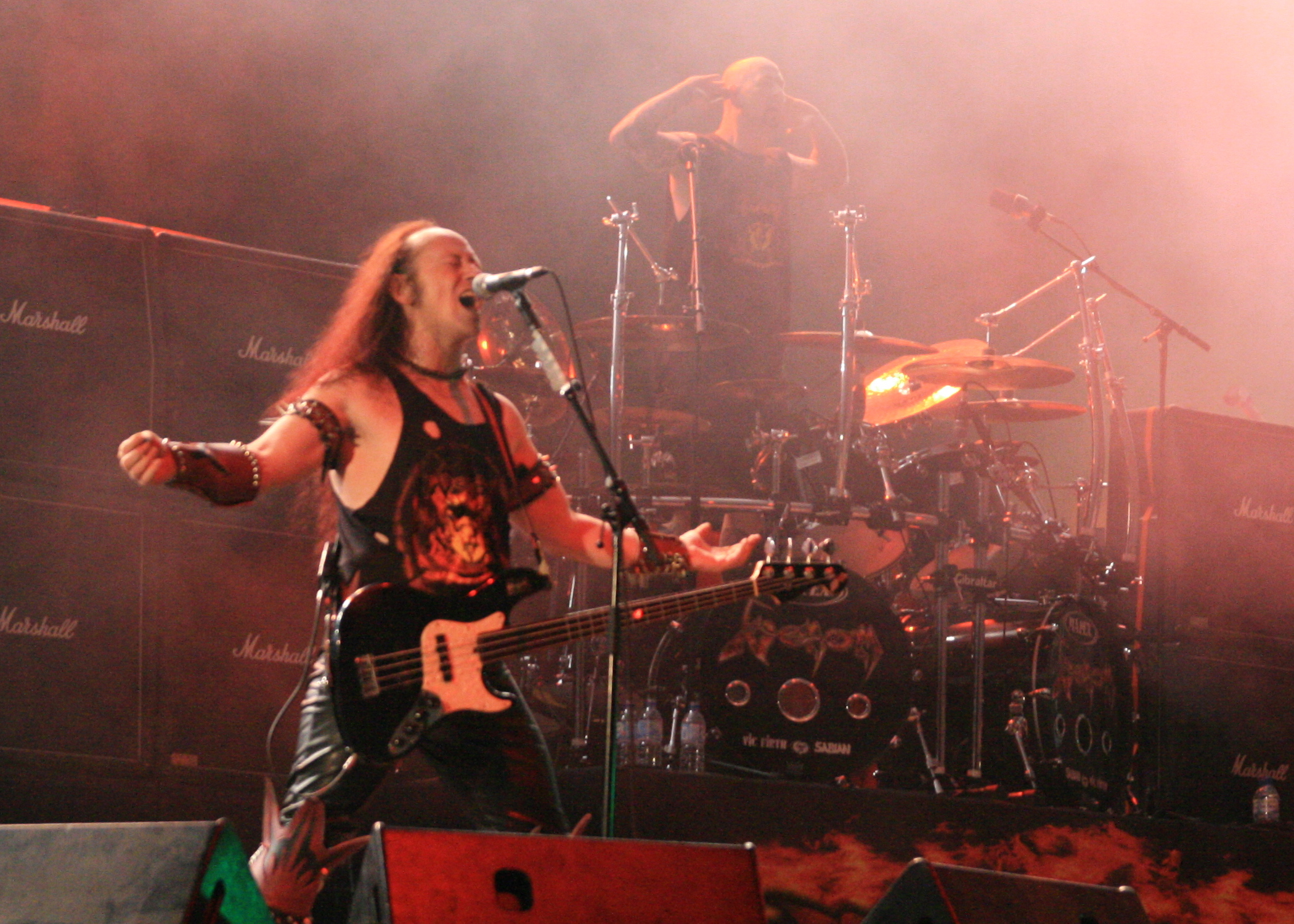|
Black Metal
Black metal is an extreme metal, extreme subgenre of heavy metal music. Common traits include Tempo#Beats per minute, fast tempos, a Screaming (music)#Black metal, shrieking vocal style, heavily distorted Electric guitar, guitars played with tremolo picking, raw (Lo-fi music, lo-fi) recording, unconventional song structures, and an emphasis on atmosphere. Artists often appear in corpse paint and adopt pseudonyms. During the 1980s, several thrash metal and death metal bands formed a prototype for black metal. This "first wave" included bands such as Venom (band), Venom, Bathory (band), Bathory, Mercyful Fate, Hellhammer and Celtic Frost. A second wave arose in the early 1990s, spearheaded by Norwegian bands such as Mayhem (band), Mayhem, Darkthrone, Burzum, Immortal (band), Immortal, Emperor (band), Emperor, Satyricon (band), Satyricon and Gorgoroth. The early Norwegian black metal scene developed the style of their forebears into a distinct genre. Norwegian-inspired black metal ... [...More Info...] [...Related Items...] OR: [Wikipedia] [Google] [Baidu] |
Viking Metal
Viking metal is a subgenre of heavy metal music characterized by a lyrical and thematic focus on Norse mythology, Norse paganism, and the Viking Age. Viking metal is quite diverse as a musical style, to the point where some consider it more a cross-genre term than a genre, but it is typically seen as black metal with influences from Nordic folk music. Common traits include a slow-paced and heavy riffing style, anthemic choruses, use of both sung and harsh vocals, a reliance on folk instrumentation, and often the use of keyboards for atmospheric effect. Viking metal emerged from black metal during the late 1980s and early 1990s, sharing with black metal an opposition to Christianity, but rejecting Satanism and occult themes in favor of the Vikings and paganism. It is similar, in lyrics, sound, and thematic imagery, to pagan metal, but pagan metal has a broader mythological focus and uses folk instrumentation more extensively. Most Viking metal bands originate from the Nordic coun ... [...More Info...] [...Related Items...] OR: [Wikipedia] [Google] [Baidu] |
National Socialist Black Metal
National Socialist black metal, also known as NSBM, Aryan black metal, and Neo-Nazi black metal, is a political movement and subgenre within the black metal music scene that promotes neo-Nazism, Fascism, and white supremacist ideologies. NSBM artists typically combine neo-Nazi imagery and ideology with ethnic European paganism, Satanism, or Nazi occultism, or a combination thereof, and vehemently oppose Christianity, Islam and Judaism from a racialist viewpoint. NSBM is not seen as a distinct genre, but as a '' völkisch'' movement within black metal. According to Mattias Gardell, NSBM musicians see this ideology as "a logical extension of the political and spiritual dissidence inherent in black metal".Mattias Gardell, ''Gods of the Blood'' (2003), p.307 NSBM artists are not always explicit with their political beliefs in the music, instead expressing their beliefs offstage. Artists who hold far-right or white nationalist beliefs but do not express these in their music are n ... [...More Info...] [...Related Items...] OR: [Wikipedia] [Google] [Baidu] |
Thrash Metal
Thrash metal (or simply thrash) is an extreme subgenre of heavy metal music characterized by its overall aggression and often fast tempo.Kahn-Harris, Keith, ''Extreme Metal: Music and Culture on the Edge'', pp. 2–3, 9. Oxford: Berg, 2007, . The songs usually use fast percussive beats and low-register guitar riffs, overlaid with shredding-style lead guitar work. The lyrical subject matter often includes criticism of The Establishment and concern over environmental destruction, and at times shares a disdain for Christian dogma with that of black metal. The language is typically direct and denunciatory, an approach borrowed from hardcore punk. The genre emerged in the early 1980s as musicians began fusing the double bass drumming and complex guitar stylings of the new wave of British heavy metal (NWOBHM) with the speed and aggression of hardcore punk. Philosophically, thrash metal developed as a backlash against both the conservatism of the Reagan Era and the much more moder ... [...More Info...] [...Related Items...] OR: [Wikipedia] [Google] [Baidu] |
Norwegian Black Metal
Much has been learned about early music in Norway from physical artifacts found during archaeological digs. These include instruments such as the lur. Viking and medieval sagas also describe musical activity, as do the accounts of priests and pilgrims from all over Europe coming to visit St Olaf's grave in Trondheim. In the later part of the 19th century, Norway experienced economic growth leading to greater industrialization and urbanization. More music was made in the cities, and opera performances and symphony concerts were considered to be of high standards. In this era both prominent composers (like Edvard Grieg and Johan Svendsen) and performers combined the European traditions with Norwegian tones. The import of music and musicians for dance and entertainment grew, and this continued in the 20th century, even more so when gramophone records and radio became common. In the last half of the 20th century, Norway, like many other countries in the world, underwent a roots revi ... [...More Info...] [...Related Items...] OR: [Wikipedia] [Google] [Baidu] |
Tremolo Picking
Alternate picking is a guitar playing technique that employs alternating downward and upward strokes in a continuous fashion. If the technique is performed at high speed on a single string or course voicing the same note, it may be referred to as "tremolo picking" or "double picking". Good alternate picking involves a continuous down-up or up-down motion of the picking hand, even when not picking a note (except when the gap lasts longer than one full up-down motion). In this manner, an up-beat (such as an even-numbered eighth note or, at faster tempos, sixteenth note) will always be played with an upward picking stroke, while the down-beats are always played with downward picking strokes. This allows for fluid incorporation of legato-based notes such as hammer-ons and/or pull-offs in the middle of picked phrases. The technique has many advantages and some disadvantages, largely depending on the licks the guitarist is attempting to play. For example, during fast passages, alt ... [...More Info...] [...Related Items...] OR: [Wikipedia] [Google] [Baidu] |
Electric Guitar
An electric guitar is a guitar that requires external amplification in order to be heard at typical performance volumes, unlike a standard acoustic guitar (however combinations of the two - a semi-acoustic guitar and an electric acoustic guitar exist). It uses one or more pickups to convert the vibration of its strings into electrical signals, which ultimately are reproduced as sound by loudspeakers. The sound is sometimes shaped or electronically altered to achieve different timbres or tonal qualities on the amplifier settings or the knobs on the guitar from that of an acoustic guitar. Often, this is done through the use of effects such as reverb, distortion and "overdrive"; the latter is considered to be a key element of electric blues guitar music and jazz and rock guitar playing. Invented in 1932, the electric guitar was adopted by jazz guitar players, who wanted to play single-note guitar solos in large big band ensembles. Early proponents of the electric guitar on ... [...More Info...] [...Related Items...] OR: [Wikipedia] [Google] [Baidu] |
Sputnikmusic
Sputnikmusic is an American music community website offering music criticism and music news alongside features commonly associated with wiki-style websites. The format of the website is unusual in that it includes both professional and amateur content, distinguishing it from professionally written music websites such as ''Pitchfork'' and ''Tiny Mix Tapes'', as well as collecting and presenting a wiki-style metadata database in a manner comparable to Rate Your Music and Discogs. Over time, the site came to be established as a credible source; it is now among the sources that Metacritic uses to compile "Critic Scores" and is used as a news source by other websites. As a general rule, the staff writers tended to focus on new releases; however, any user was welcome to submit a review of any album that has been officially released. All genres of music were covered by the site, with dedicated subsections for metal, punk, indie, rock, hip hop, and pop; an 'Other' section also caters ... [...More Info...] [...Related Items...] OR: [Wikipedia] [Google] [Baidu] |
AllMusic
AllMusic (previously known as All Music Guide and AMG) is an American online music database. It catalogs more than three million album entries and 30 million tracks, as well as information on musicians and bands. Initiated in 1991, the database was first made available on the Internet in 1994. AllMusic is owned by RhythmOne. History AllMusic was launched as ''All Music Guide'' by Michael Erlewine, a "compulsive archivist, noted astrologer, Buddhist scholar and musician". He became interested in using computers for his astrological work in the mid-1970s and founded a software company, Matrix, in 1977. In the early 1990s, as CDs replaced LPs as the dominant format for recorded music, Erlewine purchased what he thought was a CD of early recordings by Little Richard. After buying it he discovered it was a "flaccid latter-day rehash". Frustrated with the labeling, he researched using metadata to create a music guide. In 1990, in Big Rapids, Michigan, he founded ''All Music Guide' ... [...More Info...] [...Related Items...] OR: [Wikipedia] [Google] [Baidu] |
Tempo
In musical terminology, tempo (Italian, 'time'; plural ''tempos'', or ''tempi'' from the Italian plural) is the speed or pace of a given piece. In classical music, tempo is typically indicated with an instruction at the start of a piece (often using conventional Italian terms) and is usually measured in beats per minute (or bpm). In modern classical compositions, a "metronome mark" in beats per minute may supplement or replace the normal tempo marking, while in modern genres like electronic dance music, tempo will typically simply be stated in BPM. Tempo may be separated from articulation and meter, or these aspects may be indicated along with tempo, all contributing to the overall texture. While the ability to hold a steady tempo is a vital skill for a musical performer, tempo is changeable. Depending on the genre of a piece of music and the performers' interpretation, a piece may be played with slight tempo rubato or drastic variances. In ensembles, the tempo is often ind ... [...More Info...] [...Related Items...] OR: [Wikipedia] [Google] [Baidu] |
Heavy Metal Music
Heavy metal (or simply metal) is a genre of rock music that developed in the late 1960s and early 1970s, largely in the United Kingdom and United States. With roots in blues rock, psychedelic rock and acid rock, heavy metal bands developed a thick, monumental sound characterized by distortion (music), distorted guitars, extended guitar solos, emphatic Beat (music), beats and loudness. In 1968, three of the genre's most famous pioneers – Led Zeppelin, Black Sabbath and Deep Purple – were founded. Though they came to attract wide audiences, they were often derided by critics. Several American bands modified heavy metal into more accessible forms during the 1970s: the raw, sleazy sound and shock rock of Alice Cooper and Kiss (band), Kiss; the blues-rooted rock of Aerosmith; and the flashy guitar leads and party rock of Van Halen. During the mid-1970s, Judas Priest helped spur the genre's evolution by discarding much of its blues influence,Walser (1993), p. 6 while Motörhea ... [...More Info...] [...Related Items...] OR: [Wikipedia] [Google] [Baidu] |
Extreme Metal
Extreme metal is a loosely defined umbrella term for a number of related heavy metal music subgenres that have developed since the early 1980s. It has been defined as a "cluster of metal subgenres characterized by sonic, verbal, and visual transgression". The term usually refers to a more abrasive, harsher, underground, non-commercialized style associated with the speed metal, thrash metal, black metal, death metal, and doom metal genres.K. Kahn-Harris, ''Extreme Metal: Music and Culture on the Edge'' (Berg Publishers, 2007), , p. 31. Hardcore punk has been considered an integral part of the development of extreme metal, in the case of song structure and speed, in every case other than doom metal. Definitions Extreme metal acts set themselves apart from traditional heavy metal acts, such as Iron Maiden, Judas Priest and Motörhead, by incorporating more abrasive musical characteristics such as higher tempos, increased aggression and a harsher extremity. In the majority of ... [...More Info...] [...Related Items...] OR: [Wikipedia] [Google] [Baidu] |
Screaming (music)
Screaming is an extended vocal technique that is popular in "aggressive" music genres such as heavy metal, punk rock, and noise music and others. It is common in the more extreme subgenres of heavy metal, such as death and black metal as well as many other subgenres. Genres Classical and experimental music Although screams are often suggested in stories performed in the grand opera tradition, they were never performed literally, always being sung. The first significant example of an actual scream in an opera is in Alban Berg's ''Wozzeck'' (1922), where the eponymous character screams "Murder! Murder!" in the fourth scene of Act III. Even more strikingly, Berg's unfinished ''Lulu'', written mainly in 1934, features a blood-curdling scream as the heroine is murdered by Jack the Ripper in the closing moments of the final scene. In Mascagni's 1890 ''Cavalleria rusticana'' the final line "They've murdered Turiddu!" is spoken, not sung, and often accompanied by a scream. Othe ... [...More Info...] [...Related Items...] OR: [Wikipedia] [Google] [Baidu] |



.jpg)
.jpg)

